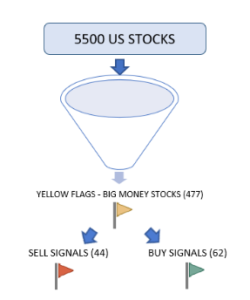Bull Crossing
Last Friday, the big money did something that historically means the bulls are ready to run.

You see, the story of the market’s future, is like many things, often written in the past.
We scan 5,500 stocks each day and get “yellow flags.” This is when big money is moving in or out of stocks in a big way.
A yellow flag is one step below a buy (green flag) or sell (red flag) signal. To get those, you need an extra high-price or low-price relationship with volume to become a buy or sell.
Out of all those stocks, we only get a handful of yellow, green, and red flags. We have 30 years of data, but looking back the last 10 years, we normally get 477 yellow flags every day. The average green flag buys are 62, and red flag sells are 44. Out of those buys and sells, we gather them up for a week and sort by score. That’s how we find the best stocks.

Last Friday we had a big stock market rally with 666 yellow flags- that’s 40% more than the 10-year average, or 2,518 trading days. But we only had 40 green buy flags- that’s 35% below average. Does that mean the market approval of the China news is just another head-fake to ignore?
Well, we looked back over the past 10 years at days where we got higher than average yellow flags and lower than average green flags, on an up day in the market: just like Friday October 11th. There were 140 times since October 12th 2009. The average rise on those 140 days was +0.96%. What we saw made our eyes grow wide.
Here it is summarized in a table:

It tells us that a big short cover rally like Friday looks great for the market. The average return for all 6 time frames is positive. And hard to believe as it may be, the S&P 500 was up a year later 135 out of 140 times averaging 13%. That’s 96% of the time.
Since Friday’s close, the S&P 500 is +1%.
Bottom Line: Looking back, history says the bulls are ready to run.
